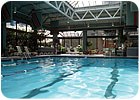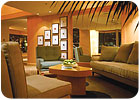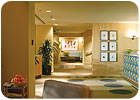
When it comes to implementing new technologies and designs, colleges and universities are often recognized as trendsetters. This includes building products and materials, which are put to the test on campuses across the country and if they work-and work well-designs, planners and developers incorporate them into a variety of products.
For instance, a walk through an Ohio university campus will reveal several buildings with solar panels on the roof, providing electricity for the buildings below. A school in Wisconsin is experimenting with a green roof to help reduce rainwater runoff, cut energy costs and minimize the "heat island" effect that makes the school's campus several degrees warmer in the summer than surrounding wooded areas. Still, another school has substituted traditional hard flooring materials for bamboo, cork and recycled materials, and the sheets of wallboard are considered green, as well. This usually means they have been green certified by such organizations as the EcoLogo Program after being evaluated and determined to be more environmentally preferable than comparable conventional wallboard coverings.
What ties all of these products together is that officials for these schools have made a conscious decision to select materials and incorporate products that encourage sustainability and help protect our environment. However, what they must also realize is that greening a facility is, to use an old adage, only as strong as its weakest link.
As more and more building products and materials become green certified, developers and administrators must understand that for a facility to be truly environmentally preferable, as many materials as possible used in its construction as well as the products, chemicals, and equipment used to operate the facility, must also be green.

Defining green
Often, green facilities refer to those buildings that encompass high-performance design. This includes operational practices, as well as the use of materials that significantly reduce or eliminate the negative impact traditional materials can have on building occupants and the environment. According to the U.S. Green Building Council, it incorporates five primary components:- Sustainable site planning
- Safeguarding of water and water efficiency
- Energy efficiency
- Conservation of materials and resources
- Indoor environmental quality
Additionally, many architects and developers were at one time unconvinced that building a high-performance facility would really be beneficial. However, a variety of studies have been released in the past couple of years that indicate student performance improves, absenteeism in both schools and offices declines, operating costs decline, and worker productivity increases when high-performance products and operating procedures are incorporated into a facility.
A third factor that slowed the adoption of sustainable materials and operating practices into facilities was confusion over what is-and is not-green. Indeed, many products introduced over the years were termed environmentally preferable or green when, in fact, later studies proved them not to be. Often this happened unintentionally because the technology available at the time mistakenly indicated the ingredients and products were green. However, at other times, the materials were simply "self-declared" green by the manufacturer.
Fortunately, much of this confusion has been eliminated with the development of recognized certifying organizations.

What is certification?
EcoLogo and other organizations, such as Green Seal, are both third-party, independent certification organizations, established to, among other things, help provide guidelines and parameters for manufacturers so that it is clear what makes a product environmentally preferable. This applies to a variety of materials, including those used on walls and ceilings in facility construction and renovation, as well as paints, flooring materials and others.The goal of these organizations is to help protect consumers so that if they purchase a green-certified product, they know it has been tested and proven to be safer for users and to have reduced impact on building occupants and the environment. At EcoLogo, a certified product bears the organization's "EcoLogo" marking, identifying it as certified green.
To have a product, such as gypsum wallboards, green certified at EcoLogo, the manufacturer must have it tested by an accredited laboratory to verify three things: (1) its ingredients, (2) whether it meets specific ISO quality control standards, and (3) whether it is in compliance with EcoLogo's green criteria for that type of product.
The lab results are submitted to EcoLogo for review along with any other pertinent data about the product. If the information indicates the product meets the criteria necessary to be certified green, a "site audit" is conducted by EcoLogo to confirm everything the laboratory has provided.
The evaluation process up to this point can take one to four weeks. However, this is not the end of the procedure. The product must be reevaluated annually to ensure it still complies with the green standards. Sometimes, the standards and criteria have been raised, in which case the manufacturer may need to reformulate the product so that it meets the new criteria.

A closer look at gypsum wall coverings
"One of the major things we are trying to do by certifying wall coverings and other building materials is to help conserve non-renewable resources," says Kevin Gallagher, vice president of EcoLogo. "The certification also requires that recycled materials be used and/or flue gas desulphurization gypsum, which is a byproduct of power generation plants. This will help reduce the amount of materials entering the waste stream."According to Gallagher, in order to bear the EcoLogo marking, some of the other environmentally preferable requirements the gypsum wallboard must meet include:
- Meeting or exceeding all applicable government and industrial safety and performance standards
- Being manufactured and transported in such a manner that all the steps of the process, including disposal of waste products in the manufacturing process, meet all applicable government laws and regulations
- Complying with standards and specifications established by ASTM International standards
- Providing detailed instructions as to proper storage, handling, and installation
The big green picture
A study conducted by Harvard University's Department of Public Health revealed that all the benefits of installing a more environmentally preferable floor can be wiped out the first time the product is cleaned with a non-green product. This tells us, as referenced earlier, that green products for walls, ceilings and other building materials, as well as the products used to clean and maintain the facility, are all interrelated components, each part of a much bigger green picture."But at this time, not all of the materials used for building construction have been green certified," says Gallagher. "Because of this, building professionals must use as many as they can. At least they are helping to reduce the use of non-renewable resources and waste, which helps protect our environment."
However, Gallagher does believe we can expect more building materials to be developed that are designed to meet green certification standards. Much of this is the result of LEED.
"Developers and building owners are finding many benefits in having their properties LEED certified," he says. "And each product used in the construction of the facility can contribute points to the LEED rating system. This will probably be the big impetus for more manufacturers of wall, ceiling, and other building materials to manufacture environmentally preferable products."
